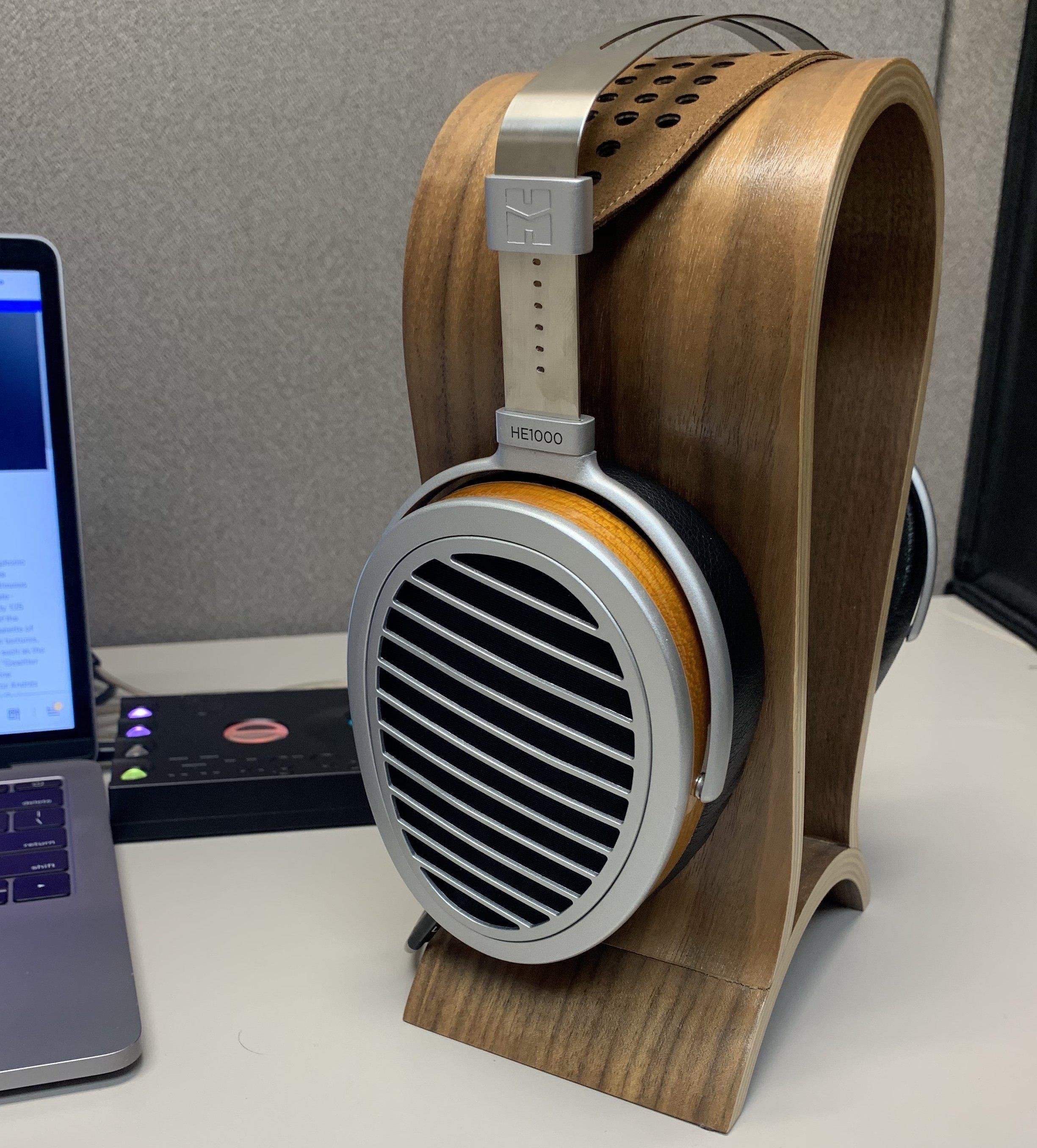The original HIFIMAN HE1000 was launched as HIFIMAN’s flagship headphones in 2015, with the improved HE1000 V2 being launched a year later. The HE1000 V2’s time at the top was short lived, as the Susvara launched in 2017 at twice the price. Now five years later HIFIMAN’s lineup looks very much the same, and with an asking price of $2999 we have to ask, is the HE1000 V2 still essentially a flagship headphone worth flagship headphone money?
The Build and Design
HIFIMAN has kept a pretty stable design in place for their top of the line headphones: metal frames, a leather suspension strap, and cups with wood accents and a thick metal grill. It’s really solid, and you can see why HIFIMAN has kept it as their signature flagship design. From a distance, they look great, but on close inspection there are aspects of the build, such as the quality of the wood grain wrap, which don’t quite match up with the expectations set by the sound and the $2999 price tag. The cables have also long been a point of contention. They’re translucent brown rubber, with quite a bit of squish to them, and careful examination will reveal that you can see the strands of copper wire running through them. Functionally, the cables are great though. I found them to be generally tangle resistant and HIFIMAN generously includes 6.3mm, 3.5mm, and balanced XLR terminations.
The entire package is quite nice. The headphones are stored in a sturdy leather wrapped box, along with the aforementioned selection of cables, and a nice paperback owner’s guide, which includes some art and design almost worthy of a place on your coffee table. With a nice package and overall solid aesthetics and build, how does the sound hold up to closer examination?
The Sound
The simple fact is that HIFIMAN HE1000 V2 (HEKv2) sounds like a flagship level headphone. The tuning is impeccably balanced, with everything from the subbass to the treble sounding “just right.” The bass is tight and punchy, and while it may seem understated at times, when it’s time to rumble, it knows how to rumble. The highs are smooth with a rolloff near the very top that eliminates a lot of the potential for harsher treble. The mids are well positioned and provide excellent detail as well as incredible cohesion and coherence through complicated passages. It has an incredible natural timbre with voices and acoustic instruments, and some of the best detail and texture in orchestral instruments that I’ve heard. The soundstage is massive, and the imaging holographic. As an extra plus, it’s not easy to drive, but it’s much easier to drive than some other top of the line planar headphones.
Stravinksy’s “Firebird Suite,” as performed by the Frankfort Radio Orchestra, was an incredible display of the HEKv2’s soundstage and imaging. In the “Introduction,” I had some of the strongest sensations I’ve ever had of actually being in a room with music playing, rather than the music being in my headphones. The sense of space and the three dimensional imaging combined with the incredible detail actually made me pause the music, get out of my seat and verify that the noise I was hearing behind me was a touch of the percussion or small artifacts in the recording, and not a person in the room with me.
Pink Floyd’s “The Wall pt. 2” provided an excellent demonstration of how well balanced the HEKv2 is. The entire song is a dance between the impact and groove at the low end, the vocal melody in the middle, and the punctuation of the guitar at the top. The slam from the driving kick drum has both solid impact and a natural texture where you can almost feel the vibration of the drum skin.
While the HEKv2’s sonic refinement initially led me away from more modern pop music, I tried out Ingrid Michaelson’s “Freak Show,” and it provided a demonstration of the HEKv2’s capabilities with modern pop music. There’s excellent bass extension and a strong sense of vibration in your head for the big bass hits. The various layers of voices and instruments were a good test of the HE1000V2’s transient response, and it demonstrated fast attack and tight, natural decay with the various background voices and instruments that weave in and out of the soundscape.
Van Halen’s “Panama” let me know that these things can rock, too. Eddie’s guitar is practically on fire, and you can hear every bit of grit in David Lee Roth’s vocals. The HEKv2 conveys a palpable energy from the band, and delivers the smooth soulful guitar licks of the bridge as well as it delivers the incendiary power of the main riff.
Comparison: HIFIMAN Arya and HIFIMAN Susvara
In HIFIMAN’s lineup, once you hit the Arya, you’re very much in top of the line territory. Depending on your listening preferences, sources and whatnot, if you’ve heard the Arya, you may be wondering why exactly you’d even want to try the HE1000 or the Susvara, or if they’re worth the upgrade. Let’s take a quick look at the differences to better understand what you’re getting.
The Arya is an incredible headphone, with a nearly “endgame” level sound for $1599. The Arya’s sound is a touch more analytical than truly neutral with some moderately elevated highs. Compared to the HEKv2, the Arya has a little more air in the highs, but also more potential for harsh or sharp tones, and the Arya can’t quite match the HEKv2’s bass response. There’s both less impact and less detail and texture to the bass. The soundstage doesn’t feel quite as large, nor does the imaging have the same level of “in the room” feeling that the HE1000 V2 provides. If you’re a fan of that extra high end, you might prefer the signature of the Arya, but in the other technical aspects, it comes up behind the HEKv2.
The Susvara comes in on the other side of the HEKv2. Priced at $5999, it may be the ultimate endgame headphone. In terms of tuning, the Susvara has a touch of the Arya’s treble that the HEKv2 is lacking, but is overall closer to the HEKv2. The bass response is also very close to the HEKv2 with the Susvara providing just a touch more impact. And in terms of the soundstage and imaging, the Susvara is just a little bit bigger, and has more noticeably vivid imaging with some tracks.
Having all three to compare, the Arya represents the strongest value, with all of the attributes that make the HEKv2 and Susvara absolutely legendary headphones, but just turned down a couple notches. The HEKv2 feels very much like a flagship headphone, like every technical aspect is turned all the way up to 10, but then the Susvara comes in, and it goes up to 11. If you need the absolute best in every attribute and money is no object, the Susvara is certainly the winner, but if you want something that’s 90% of the Susvara at 50% of price, don’t sleep on the HEKv2.
The Bottom Line
The HE1000 V2 delivers incredible detail, accuracy, soundstage, and imaging in a flagship level, top of the line package. While you might not think of $2999 headphones as being a “great value,” considering how well the HE1000 V2 performs next to the $5999 Susvara, they’re an absolute steal.








